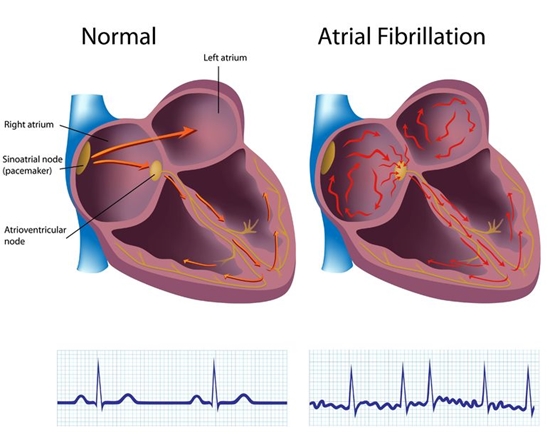برآورد بار فیبریلاسیون دهلیزی و فلوتر دهلیزی با پیشبینی تا سال 2050 در ایران
فیبریلاسیون دهلیزی (AF) و فلوتر دهلیزی (AFL) شایعترین نوع تاکیآریتمی قلبی هستند و در سالهای اخیر روند افزایش بار این بیماریها مشاهده شده است. با این حال، بار AF/AFL در ایران همچنان نامشخص است. این مطالعه با هدف برآورد بار AF/AFL و عوامل خطر قابل انتساب به آن از سال 1990 تا 2019 انجام شده است.

این مقاله به بررسی بار بیماریهای فیبریلاسیون دهلیزی (AF) و فلوتر دهلیزی (AFL) در ایران از سال 1990 تا 2019 پرداخته و پیشبینی آن را تا سال 2050 انجام داده است. به زبان ساده، این مطالعه نشان میدهد که تعداد افراد مبتلا به این اختلالات ریتم قلبی در حال افزایش است و انتظار میرود این روند ادامه یابد. در سال 2019، بیش از 339 هزار نفر در ایران به AF/AFL مبتلا بودند و حدود 30 هزار مورد جدید گزارش شده است. این اختلالات میتوانند به عوارض جدی مانند نارسایی قلبی و سکته مغزی منجر شوند.
مطالعه نشان میدهد که فشار خون بالا و چاقی عوامل کلیدی در افزایش موارد و مرگ و میر ناشی از AF/AFL هستند. افراد مسن، به ویژه کسانی که در رده سنی 50 تا 69 سال هستند، بیشترین تأثیر را از این بیماریها میبینند و مردان نیز از نظر تعداد موارد در حال نزدیک شدن به زنان هستند.
پیشبینیها تا سال 2050 نشان میدهد که تعداد افراد مبتلا به AF/AFL در ایران به 1.1 میلیون نفر خواهد رسید و موارد و مرگ و میر بیشتری انتظار میرود، که این امر این بیماریها را به یک مسئله مهم بهداشتی تبدیل میکند. این نتایج بر لزوم بهبود راهبردهای پیشگیری، با تمرکز بر عوامل قابل کنترل مانند فشار خون بالا و چاقی تأکید دارد.
Estimating the burden of atrial fibrillation and atrial flutter with projection to 2050 in Iran
Atrial fibrillation (AF)/atrial flutter (AFL) is the most common cardiac tachyarrhythmia, with an increasing trend in its burden in recent years. However, the burden of AF/AFL in Iran remains unclear. This study aimed to estimate the burden of AF/AFL and its attributable risk factors from 1990 to 2019 at national and subnational levels. Using the comparative risk assessment method of the Global Burden of Disease (GBD) Study 2019, we extracted data on AF/AFL incidence, prevalence, deaths, disability-adjusted life years (DALYs), and their age-standardized rates from 1990 to 2019 and analyzed them based on by age, sex, and socio-demographic index (SDI). The percentage contribution of AF/AFL major risk factors was calculated. Moreover, the AF/AFL burden in 2050 was projected using the United Nations world population prospect data. In 2019, there were 339.1 (259.4–433.7) thousand AF/AFL patients in Iran, with 30.2 (23.2–38.5) thousand new cases, 1.7 (1.5–2) thousand deaths and 48 (37.7–60.5) thousand DALYs. Females and 50–69-year-old patients recorded a higher burden for AF/AFL; however, the increasing trend was more pronounced in males and more than 85-year-old patients. High systolic blood pressure and elevated body mass index (BMI) were the predominant attributable risk factors for AF/AFL-related deaths and DALYs. It is estimated that in 2050, the number of AF/AFL patients will increase to 1.1 million people, the incidence of AF/AFL will increase to 91 thousand patients, and the number of AF/AFL-related deaths and DALYs will surge to 7.2 and 170.8 thousand, respectively. Despite advancements in prevention and treatment, AF/AFL remains a major public health problem in Iran. Given its largely preventable and treatable nature, more cost-effective strategies are required to target modifiable risk factors, especially within susceptible age and sex groups.


.png)
.png)
ارسال نظر